Cabinet Secretariat [Wednesday, December 28, 2016]
The Power of Reconciliation: Address by Prime Minister Shinzo Abe
December 27, 2016, Pearl Harbor
President Obama, Commander Harris, ladies and gentlemen, and all American citizens,
I stand here at Pearl Harbor as the prime minister of Japan.
If we listen closely we can make out the sound of restless waves, breaking and then retreating again. The calm inlet of brilliant blue is radiant with the gentle sparkle of the warm sun.
Behind me, a striking white form atop the azure, is the USS Arizona Memorial.
Together with President Obama, I paid a visit to that memorial, the resting place for many souls.
It was a place which brought utter silence to me.
Inscribed there are the names of the servicemen who lost their lives.
Sailors and marines hailing from California and New York, Michigan and Texas, and various other places, serving to uphold their noble duty of protecting the homeland they loved, lost their lives amidst searing flames that day, when aerial bombing tore the USS Arizona in two.
Even 75 years later, the USS Arizona, now at rest atop the seabed, is the final resting place for a tremendous number of sailors and marines.
Listening again as I focus my senses, alongside the song of the breeze and the rumble of the rolling waves, I can almost discern the voices of those crewmen.
Voices of lively conversations, upbeat and at ease, on that day, on a Sunday morning.
Voices of young servicemen talking to each other about their futures and dreams.
Voices calling out the names of loved ones in their very final moments.
Voices praying for the happiness of children still unborn.
Each and every one of those servicemen had a mother and a father anxious about his safety.
Many had wives and girlfriends they loved. And many must have had children they would have loved to watch grow up.
All of that was brought to an end. When I contemplate that solemn reality, I am rendered entirely speechless.
“Rest in peace, precious souls of the fallen.” With that overwhelming sentiment, I cast flowers on behalf of Japanese people, upon the waters where those sailors and marines sleep.
* * *
President Obama, the people of the United States of America, and the people around the world,
As the prime minister of Japan, I offer my sincere and everlasting condolences to the souls of those who lost their lives here, as well as to the spirits of all the brave men and women whose lives were taken by a war that commenced in this very place, and also to the souls of the countless innocent people who became victims of the war.
We must never repeat the horrors of war again.
This is the solemn vow we, the people of Japan, have taken. And since the war, we have created a free and democratic country that values the rule of law and has resolutely upheld our vow never again to wage war.
We, the people of Japan, will continue to uphold this unwavering principle, while harboring quiet pride in the path we have walked as a peace-loving nation over these 70 years since the war ended.
To the souls of the servicemen who lie in eternal rest aboard the USS Arizona, to the American people, and to all peoples around the world, I pledge that unwavering vow here as the prime minister of Japan.
* * *
Yesterday, at the Marine Corps Base Hawaii in Kaneohe Bay, I visited the memorial marker for an Imperial Japanese Navy officer.
He was a fighter pilot by the name of Commander Fusata Iida who was hit during the attack on Pearl Harbor and gave up on returning to his aircraft carrier. He went back instead and died.
It was not Japanese who erected a marker at the site that Iida’s fighter plane crashed. It was U.S. servicemen who had been on the receiving end of his attack.
Applauding the bravery of the dead pilot, they erected this stone marker.
On the marker, his rank at that time is inscribed, “Lieutenant, Imperial Japanese Navy,” showing their respect toward a serviceman who gave his life for his country.
“The brave respect the brave.”
So wrote Ambrose Bierce in a famous poem.
Showing respect even to an enemy they fought against; trying to understand even an enemy that they hated --- therein lies the spirit of tolerance embraced by the American people.
When the war ended and Japan was a nation in burnt-out ruins as far as the eye could see, suffering under abject poverty, it was the United States, and its good people, that unstintingly sent us food to eat and clothes to wear.
The Japanese people managed to survive and make their way toward the future thanks to the sweaters and milk sent by the American people.
And it was the United States that opened up the path for Japan to return to the international community once more after the war.
Under the leadership of the United States, Japan, as a member of the free world, was able to enjoy peace and prosperity.
The goodwill and assistance you extended to us Japanese, the enemy you had fought so fiercely, together with the tremendous spirit of tolerance were etched deeply into the hearts and minds of our grandfathers and mothers.
We also remember them. Our children and grandchildren will also continue to pass these memories down and never forget what you did for us.
The words pass through my mind; those words inscribed on the wall at the Lincoln Memorial in Washington D.C. where I visited with President Obama.
“With malice toward none, with charity for all… let us strive on… to do all which may achieve and cherish a… lasting peace among ourselves and with all nations.”
These are the words of President Abraham Lincoln.
On behalf of the Japanese people, I hereby wish to express once again my heartfelt gratitude to the United States and to the world for the tolerance extended to Japan.
* * *
It has now been 75 years since that “Pearl Harbor.” Japan and the United States, which fought a fierce war that will go down in the annals of human history, have become allies with deep and strong ties rarely found anywhere in history.
We are allies that will tackle together, to an even greater degree than ever before, the many challenges covering the globe.
Ours is an “alliance of hope” that will lead us to the future.
What has bonded us together is the power of reconciliation, made possible through the spirit of tolerance.
What I want to appeal to the people of the world, here at Pearl Harbor, together with President Obama, is this power of reconciliation.
Even today, the horrors of war have not been eradicated from the surface of the world. There is no end to the spiral where hatred creates hatred.
The world needs the spirit of tolerance and the power of reconciliation now -- and especially now.
Japan and the United States, which have eradicated hatred and cultivated friendship and trust on the basis of common values, are now, and especially now, taking responsibility for appealing to the world about the importance of tolerance and the power of reconciliation.
That is precisely why the Japan-U.S. alliance is “an alliance of hope.”
* * *
The inlet gazing at us is tranquil as far as the eye can see.
Pearl Harbor.
It is precisely this beautiful inlet, shimmering like pearls, that is a symbol of tolerance and reconciliation.
It is my wish that our Japanese children, and President Obama, your American children, and indeed their children and grandchildren, and people all around the world, will continue to remember Pearl Harbor as the symbol of reconciliation.
We will spare no efforts to continue our endeavors to make that wish a reality. Together with President Obama, I hereby make my steadfast pledge.
Thank you very much.
Cabinet Secretariat [Wednesday, December 28, 2016]
Visit to the United States: First Day
On December 26 (local time), Prime Minister Shinzo Abe visited Honolulu in the United States of America.
The Prime Minister offered wreaths at the National Memorial Cemetery of the Pacific, the Makiki Japanese Cemetery, the Ehime Maru Memorial, and the Lieutenant Fusata Iida Memorial. The Prime Minister then visited the Central Identification Laboratory of the Defense POW/MIA Accounting Agency, United States Department of Defense, before attending a dinner banquet with people of Japanese descent.
In his address at the dinner banquet, the Prime Minister said,
“Good evening, everyone. Aloha. When you all say ‘Aloha’ to me, I feel warmly welcomed.
Since 1868, the first year of the Meiji Period, many people with big dreams have emigrated to Hawaii from Japan. However, I have heard that their labor in the sugarcane plantations under the blazing sun was harsher than they had expected, and in the face of these tough conditions, their early dreams were short-lived.
Nevertheless, I have been told that the Issei, or members of the first generation, put up with their hardship, thinking that ‘it can’t be helped’ or ‘shikata ga nai,’ and passed their own dreams and hopes on to the children of the next generation. My thoughts turned to your predecessors in Hawaii when I visited the Makiki Japanese Cemetery today.
After the attack on Pearl Harbor 75 years ago, people of Japanese descent were placed in the position of having their two homelands divided against each other. The distinguished service of the 100th Infantry Battalion and the 442nd Regimental Combat Team, both comprised of people of Japanese descent, is famous. I feel deeply moved by the fact that many Nisei or second-generation people of Japanese descent demonstrated their loyalty to the country that brought them up and that they felt duty-bound to serve, and gave their all to protect their families.
When I visited the United States in May last year, I also offered a wreath at the Go For Broke Monument for Japanese-American World War II veterans. Today I would like to once again express my heartfelt respect to all of the second-generation veterans of Japanese descent.
Former Governor of Hawaii George Ariyoshi and his wife Jean Ariyoshi have kindly joined us here today. They were also friends of my father. I am aware that a phrase that Governor Ariyoshi treasured from the time when he was serving as governor, which expressed his feeling of gratitude, was ‘okage sama de,’ meaning ‘with obligation to all.’
As World War II drew to a close, Governor Ariyoshi enlisted in the army, and after the end of the war, he served as a member of the forces occupying Japan. In front of the building where he worked at that time, there were apparently always groups of poor young boys hanging around, who had lost their parents in the war and were working as shoe-shine boys. Governor Ariyoshi took a liking to one of the boys who, though dressed shabbily, always took his work seriously. One day, feeling sorry for the boy, who was always hungry, Governor Ariyoshi made him some sandwiches in the kitchen. When he gave them to the boy, saying, ‘You must be hungry; eat these,’ the boy wrapped them in a napkin and put them away carefully in his shoe box.
Apparently, when Governor Ariyoshi said, ‘You don’t need to be shy, you can eat them now,’ the boy said, ‘I will share these sandwiches you have kindly given me with my hungry little sister at home,’ and gave a well-mannered and deep bow. This boy, despite being shabbily dressed and always hungry, never forgot to show kindness to his younger sister, and responded politely to Governor Ariyoshi. Seeing this, Governor Ariyoshi felt deeply moved.
Governor Ariyoshi, shocked by the sight of Japan, which had lost the war and lay in miserable devastation, says that when he saw this boy, who no matter how poor he was, retained his pride and good manners, and did not forget to be kind to others, he realized that, like this boy, he himself also had Japanese blood, and was able to feel pride in this heritage.
After the Great East Japan Earthquake of March 11, 2011, I heard this story from Governor Ariyoshi, who was then visiting Japan, and was truly encouraged. I recall now that at the time I vowed in my heart that, in the spirit that Governor Ariyoshi experienced in 1945 of never forgetting to be proud of Japan and of being Japanese, we too must recover from the disaster.
I am sure that many people of Japanese descent have overcome a great many difficulties, while feeling both proud of their Japanese roots, and at the same time pride and loyalty towards their homeland, the United States. As the Prime Minister of Japan, I would like to express my thanks and gratitude to all the people of Japanese descent for your contributions to Hawaii and to the United States, and for the major role you have played as a bridge between Japan and the United States.
Hawaii has always been a place that I have held in high esteem. Before the war, my grandmother’s cousin emigrated to Hawaii. Her name was Hanako, a very common Japanese girl’s name at the time, and she was one of the émigrés from Yamaguchi Prefecture. She married a Mr. Nakata, and after that they often sent us various wonderful delicious things from Hawaii. At the time Japan was still poor. Even now, I remember the candy lei she sent us, made with so much chewing gum and chocolate. My older brother and I fought over the candy lei, and as a result, it broke. Even now, I recall how I cried for an entire day over that lei. I wondered if the people of Hawaii ate such delicious things every day. I remember desperately wanting to visit Hawaii. The first time I saw a genuine pineapple was when the Nakatas sent us one. Up until then, my father, mother, brother and I had only ever seen canned pineapple, so we looked at the real pineapple for quite a while, trying to figure out how to eat it.
I am delighted that I am now able to visit Hawaii, which I had always thought so highly of, as Prime Minister, and that I am spending this enjoyable evening with all you wonderful people of Japanese descent, of whom we Japanese people feel very proud.
Furthermore, many people are attending today who have a link with Japanese-American communities, or a connection with Japan, including Admiral Harry B. Harris, Jr., Commander of the US Pacific Command, and Admiral Katsutoshi Kawano, Chief of Staff of the Joint Staff of the Japan Self-Defense Forces, whose father was on board a submarine that took part in the Pearl Harbor operation. That is to say that Admiral Kawano’s father actually participated in the attack on Pearl Harbor, whereas his son, Admiral Kawano, is now playing a central role in strengthening the bonds of the Japan-US Alliance.
Tomorrow I will visit Pearl Harbor with President Barack Obama. We will pay our respects there, and I would like to show Japan and the United States, as well as the rest of the world, the power of reconciliation. As an ‘Alliance of Hope,’ Japan and the United States will continue to jointly face the various issues facing the region and world, and to jointly address them.
I would like to express my heartfelt thanks to Governor David Yutaka Ige and his wife Dawn Amano-Ige, for jointly hosting this event. Governor Ige’s father was a Sansei or third-generation person of Japanese descent who served in the 100th Infantry Battalion, while his mother comes from my hometown, Yamaguchi Prefecture. Once again, I would like to offer my sincere thanks.
I would like to end my remarks by once again expressing my profound gratitude to all those in attendance today, many of whom have taken the time to travel here from all over.
I would now like to raise a toast to the longevity and good health of everyone here this evening.”
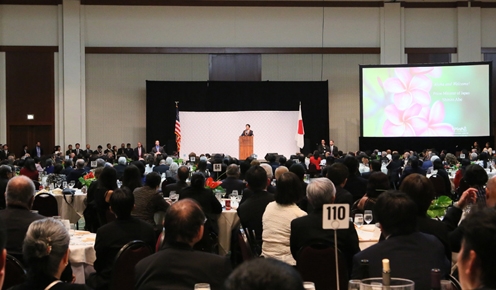
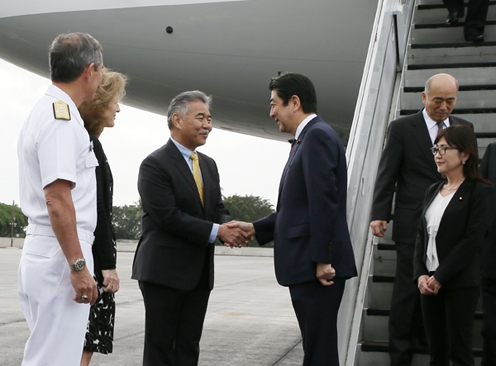
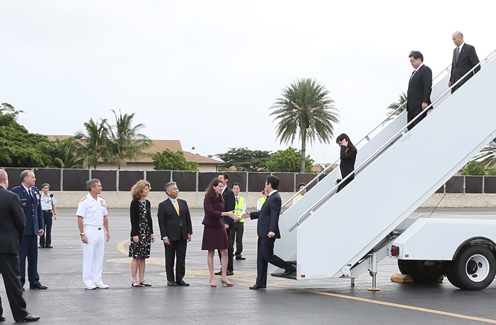
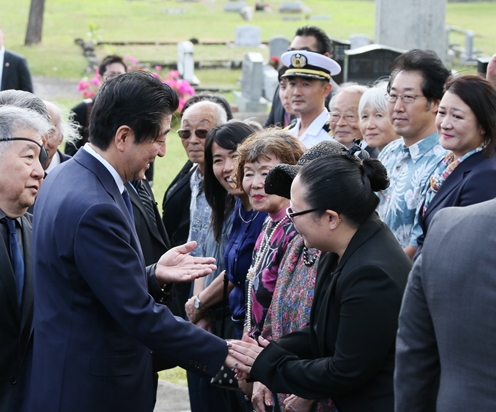
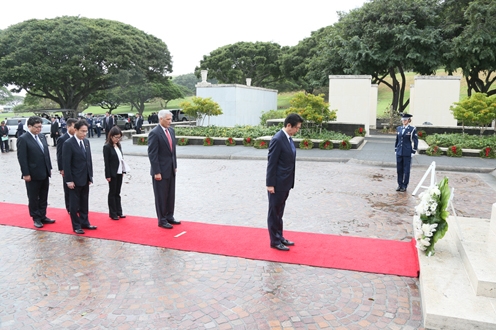
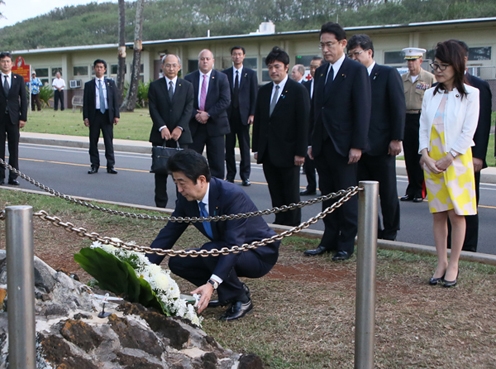
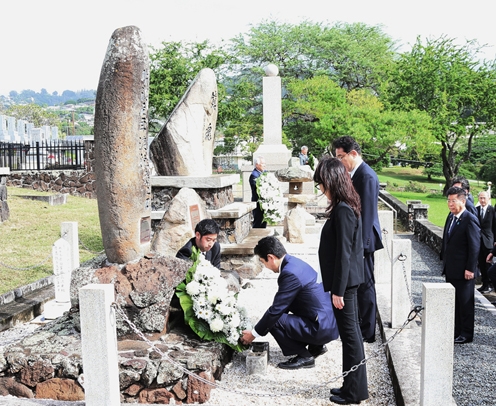
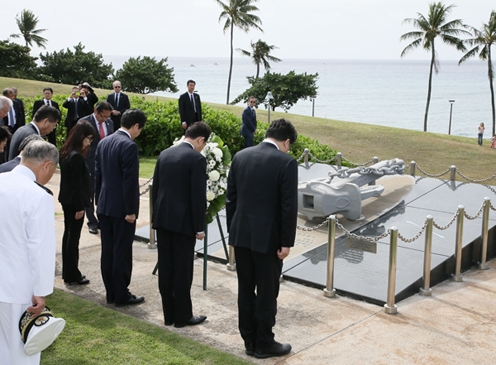
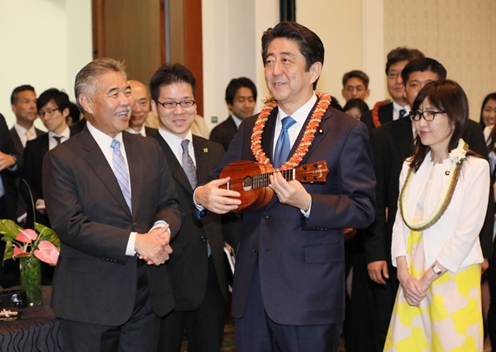
Cabinet Secretariat [Wednesday, December 28, 2016]
Visit to the United States: Second Day
On December 27 (local time), Prime Minister Shinzo Abe, who is visiting Honolulu in the United States of America, visited the Pearl Harbor Visitor Center.
Prime Minister Abe then held a summit meeting with the Honorable Barack H. Obama, President of the United States of America. Afterwards, the two leaders visited the USS Arizona Memorial and delivered a statement, respectively.
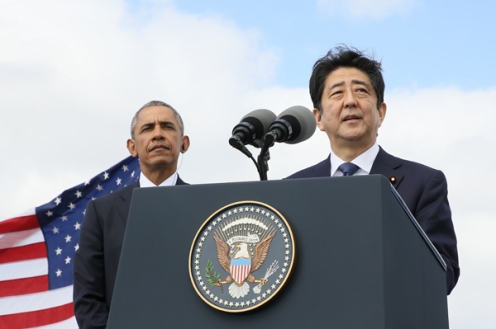
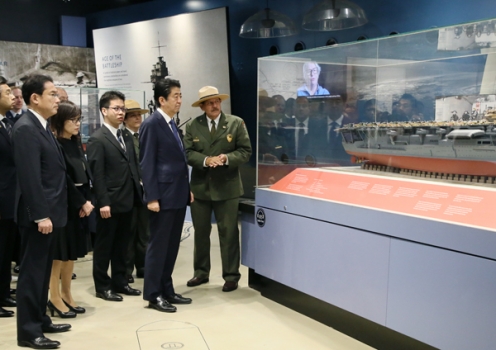
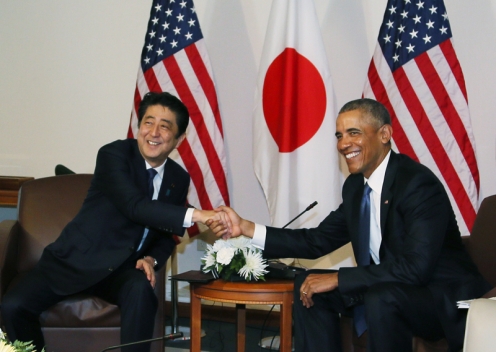
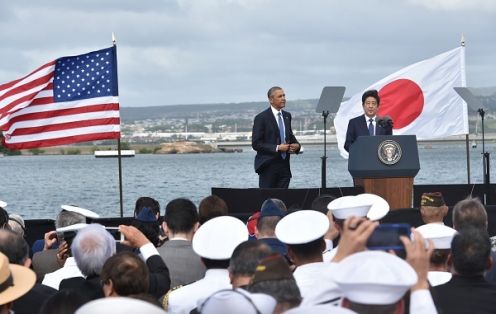
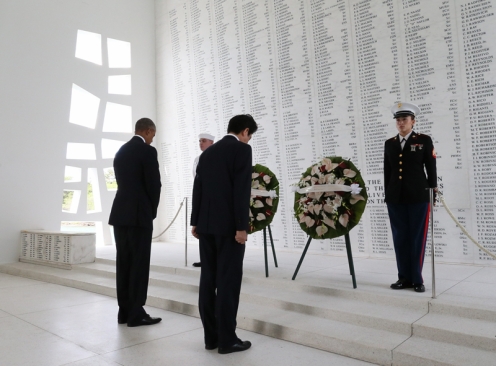
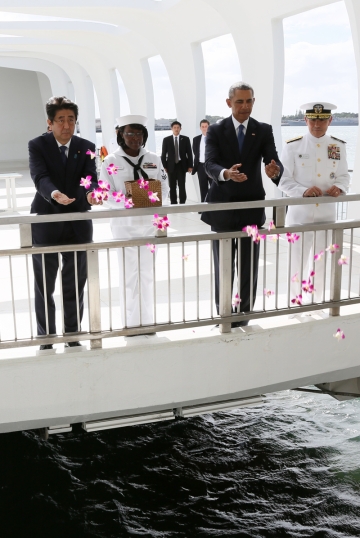

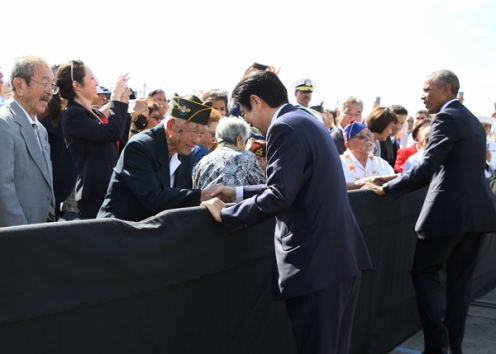
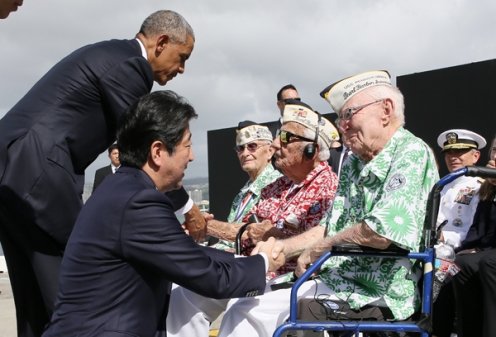
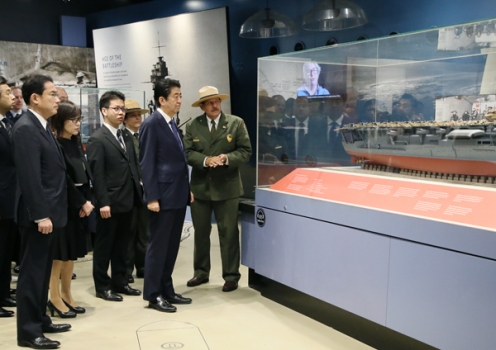

Ministry of Foreign Affairs [Wednesday, December 28, 2016]
Visit by Prime Minister Abe to Hawaii
From December 26 to 27, Mr. Shinzo Abe, Prime Minister of Japan, visited the Island of Oahu, the State of Hawaii, the United States of America. The overview is as follows.
1. Schedule
2. Visit to the National Memorial Cemetery of the Pacific
3. Visit to the Japanese Section of Makiki Cemetery
4. Visit to the Ehime Maru Memorial
5. Visit to the Memorial for Commander Fusata Iida
6. Visit to the Central Identification Laboratory (CIL) of the United States Defense POW/MIA Accounting Agency (DPAA), the Department of Defense
7. Dinner Banquet with People of Japanese Descent
8. Visit to the Pearl Harbor Visitor Center
9. Japan-U.S. Summit Meeting
10. Visit to the USS Arizona Memorial 11. Statements by the Two Leaders
1. Schedule
(1) December 26 (MON)
Visit to the National Memorial Cemetery of the Pacific
Visit to the Japanese Section of Makiki Cemetery
Visit to the Ehime Maru Memorial
Visit to the Memorial for Commander Fusata Iida
Visit to the Central Identification Laboratory (CIL) of the Defense POW/MIA Accounting Agency (DPAA), the Department of Defense
Dinner Banquet with People of Japanese Descent
(2) December 27 (TUE)
Visit to the Pearl Harbor Visitor Center
Japan-U.S. Summit Meeting
Visit to the USS Arizona Memorial
Statements by the Two Leaders
2. Visit to the National Memorial Cemetery of the Pacific
Prime Minister Abe visited the National Memorial Cemetery of the Pacific where the war dead and others from the Pacific region are buried. Guided by Mr. James Horton, Director of the National Memorial Cemetery of the Pacific, the Prime Minister proceeded to lay a wreath, and offered a silent prayer. Prime Minister Abe then signed his name on the guestbook of the cemetery. He also offered flowers and a silent prayer at the gravestone of the late Senator Daniel Inouye and recalled a man who made enormous contribution to the strengthening of the bond between Japan and the United States.
Those who accompanied Prime Minister Abe to this event include the following: Mr. Fumio Kishida, Minister for Foreign Affairs; Ms. Tomomi Inada, Minister for Defense; Mr. Koichi Hagiuda, Deputy Chief Cabinet Secretary; Mr. Seiichi Eto, Special Advisor to the Prime Minister; Mr. Hiromi Yoshida, Chairperson, Japan-Hawaii Legislators’ Friendship Association, LDP House of Councillors; Mr. Masaji Matsuyama, Chief Whip, Japan-Hawaii Legislators’ Friendship Association, LDP House of Councillors; Mr. Iwao Horii, Secretary General, Japan-Hawaii Legislators’ Friendship Association, LDP House of Councillors; Her Excellency Ms. Caroline Kennedy, Ambassador of the United States to Japan; Mr. David Yutaka Ige, Governor of the State of Hawaii; and Lieutenant General Jerry P. Martinez, Commander, United States Forces Japan.
3. Visit to the Japanese Section of Makiki Cemetery
Prime Minister Abe visited the Japanese Section of Makiki Cemetery in Honolulu. After receiving explanations on the cemetery and monuments from Mr. Noboru Hayase, President of Hawaii Meiji Kai, and Mr. Dean Asahina, President of the United Japanese Society of Hawaii, the Prime Minister laid wreaths and offered silent prayers at the following monuments: the monument to 1868 Japanese pioneer immigrants (note: 1868 is the first year of the Meiji period); the monument for the repose of souls; and the monument to Japanese immigrants in Hawaii. Prime Minister Abe then signed his name on the guestbook of the cemetery. Prime Minister Abe also exchanged words with the representatives of Hawaii Meiji Kai and United Japanese Society of Hawaii.
Those who accompanied Prime Minister Abe to this event include the following: Mr. Fumio Kishida, Minister for Foreign Affairs; Ms. Tomomi Inada, Minister for Defense; Mr. Koichi Hagiuda, Deputy Chief Cabinet Secretary; Mr. Seiichi Eto, Special Advisor to the Prime Minister; Mr. Hiromi Yoshida, Chairperson, Japan-Hawaii Legislators’ Friendship Association, LDP House of Councillors; Mr. Masaji Matsuyama, Chief Whip, Japan-Hawaii Legislators’ Friendship Association, LDP House of Councillors; Mr. Iwao Horii, Secretary General, Japan-Hawaii Legislators’ Friendship Association, LDP House of Councillors; Her Excellency Ms. Caroline Kennedy, Ambassador of the United States to Japan; Mr. David Yutaka Ige, Governor of the State of Hawaii; and Lieutenant General Jerry P. Martinez, Commander, United States Forces Japan.
4. Visit to the Ehime Maru Memorial
Prime Minister Abe visited the Ehime Maru Memorial located in Kakaako Waterfront Park. After receiving explanations on the accident and the Memorial from Mr. Hisao Miwa, Chairman of Japan-America Society of Hawaii, the Prime Minister laid a wreath and offered a silent prayer at the memorial monument. Prime Minister Abe also exchanged words with Mr. Earl K. Okawa, President of the Ehime Maru Memorial Association, and those engaged in volunteer cleaning of the Memorial.
Those who accompanied Prime Minister Abe to this event include the following: Mr. Fumio Kishida, Minister for Foreign Affairs; Ms. Tomomi Inada, Minister for Defense; Mr. Koichi Hagiuda, Deputy Chief Cabinet Secretary; Mr. Seiichi Eto, Special Advisor to the Prime Minister; Mr. Hiromi Yoshida, Chairperson, Japan-Hawaii Legislators’ Friendship Association, LDP House of Councillors; Mr. Masaji Matsuyama, Chief Whip, Japan-Hawaii Legislators’ Friendship Association, LDP House of Councillors; Mr. Iwao Horii, Secretary General, Japan-Hawaii Legislators’ Friendship Association, LDP House of Councillors; Her Excellency Ms. Caroline Kennedy, Ambassador of the United States to Japan; Mr. David Yutaka Ige, Governor of the State of Hawaii; and Lieutenant General Jerry P. Martinez, Commander, United States Forces Japan.
On February 9, 2001 (February 10 Japan time), the Ehime Maru, a training vessel of Ehime Prefectural Uwajima Fishery High School, sank as a result of the collision with the USS Greeneville, a nuclear-powered submarine, when the submarine abruptly surfaced. Nine persons (four trainees, two instructors, and three crewmembers) lost their lives in this event.
This memorial was built on a slightly elevated hill in Kakaako Waterfront Park and was unveiled on February 9, 2002, one year after the accident. The intention of the memorial is to pray for the victims and for the safety of the world’s seas and to wish that the peoples of Ehime Prefecture and the United States will overcome this unfortunate event, deepen mutual understanding, and promote friendship and goodwill.
5. Visit to the Memorial for Commander Fusata Iida
Prime Minister Abe visited the memorial for Commander Fusata Iida of the Imperial Japanese Navy, which was built by the United States at the Marine Corps base in Kaneohe Bay, the largest base of the U.S. Marine Corps in Hawaii. After receiving explanation from Mr. Daniel Martinez, Chief Historian of the WWII Valor, on this monument to remember the bravery of Commander Iida, Prime Minister Abe laid a wreath and offered a silent prayer.
Those who accompanied Prime Minister Abe to this event include the following: Mr. Fumio Kishida, Minister for Foreign Affairs; Ms. Tomomi Inada, Minister for Defense; Mr. Koichi Hagiuda, Deputy Chief Cabinet Secretary; Mr. Seiichi Eto, Special Advisor to the Prime Minister; Mr. Hiroshi Imazu, Member of the House of Representatives; Mr. Ryota Takeda, Member of the House of Representatives (Chief Whip, Japan-Hawaii Legislators’ Friendship Association, LDP House of Representatives); Mr. Yasuhide Nakayama, Member of the House of Representatives; Lieutenant General David H. Berger, Commander, U.S. Marine Corps Forces Pacific; and Lieutenant General Jerry P. Martinez, Commander, United States Forces Japan.
Commander Fusata Iida participated in the attack on Pearl Harbor as a Zero fighter pilot stationed on the aircraft carrier Soryu. During an attack on the Kaneohe base, his fuel tank was hit by a bullet. After giving a hand signal indicating that he was out of fuel, he waved his hands and then flew into a hangar of the Kaneohe base.
The U.S. Navy praised Commander Iida’s valor and respectfully buried his body inside the Kaneohe base. In 1971, 30 years after the attack on Pearl Harbor, the United States constructed a memorial for Commander Iida next to the runway at the Kaneohe base, which is Hawaii’s largest U.S. Marine Corps base located in northeastern Oahu. Even today, the memorial is being maintained and managed by the U.S. Marine Corps.
6. Visit to the Central Identification Laboratory (CIL) of the United States Defense POW/MIA Accounting Agency (DPAA), the Department of Defense
Prime Minister Abe visited the Central Identification Laboratory (CIL) of the Defense POW/MIA Accounting Agency (DPAA), the Department of Defense, which is an agency specialized in accounting soldiers and others who went missing. Prime Minister Abe received explanations from Brigadier General Mark Spindler, acting Director of DPAA, on this Laboratory. Guided by Dr. John Byrd, Director of the CIL, the Prime Minsiter observed the remains stored within the CIL as well as the examination work for the accounting process.
Those who accompanied Prime Minister Abe to this event include the following: Mr. Fumio Kishida, Minister for Foreign Affairs; Ms. Tomomi Inada, Minister for Defense; Mr. Koichi Hagiuda, Deputy Chief Cabinet Secretary; Mr. Seiichi Eto, Special Advisor to the Prime Minister; Mr. Hiroshi Imazu, Member of the House of Representatives; Mr. Ryota Takeda, Member of the House of Representatives (Chief Whip, Japan-Hawaii Legislators’ Friendship Association, LDP House of Representatives); Mr. Yasuhide Nakayama, Member of the House of Representatives; and Sergeant Major Michael E. Swam, Senior Enlisted Leader, DPAA.
7. Dinner Banquet with People of Japanese Descent
Prime Minister Abe participated in a dinner banquet with approximately 1,000 people, including representatives of organizations for people of Japanese descent living in Hawaii, and government officials from the State of Hawaii. In his speech, Prime Minister Abe, looking back on the history of the people of Japanese descent in Hawaii, expressed his gratitude once again to the Japanese-Americans for their significant contributions to the Japan-U.S. relationship. The Prime Minister shared the story of Mr. George Ryoichi Ariyoshi, former Governor of the State of Hawaii, meeting a small boy mired in poverty but never lost pride and kindness after the war. He also mentioned that his dream place had been Hawaii since his early childhood and stated the importance of the further development of the special Japan-Hawaii and Japan-U.S. relations.
In response, Mr. David Yutaka Ige, Governor of the State of Hawaii, welcomed the visit of Prime Minister Abe and recognized his visit to Pearl Harbor as highly meaningful. Governor Ige also expressed his expectation for further strengthening of the family-like Japan-Hawaii relationship.
In addition, former Governor Ariyoshi, who made remarks on behalf of the people of Japanese descent in Hawaii, welcomed Prime Minister Abe and expressed his appreciation for Prime Minister’s contributions not only to the strengthening of the Japan-U.S. relationship, but also to the peace and prosperity of the Asia Pacific Region. Mr. Jake Shimabukuro, a well-known musician, played the ukulele. The banquet was held in a very friendly atmosphere.
8. Visit to the Pearl Harbor Visitor Center
Prime Minister Abe visited the Pearl Harbor Visitor Center and received explanations with regard to the displays from Mr. Daniel Martinez, Chief Historian of the WWII Valor, National Park Service, at the two exhibit galleries.
Those who accompanied Prime Minister Abe to this event include the following: Mr. Fumio Kishida, Minister for Foreign Affairs; Ms. Tomomi Inada, Minister for Defense; Mr. Koichi Hagiuda, Deputy Chief Cabinet Secretary; and Mr. Seiichi Eto, Special Advisor to the Prime Minister.
The Pearl Harbor Visitor Center has two exhibit galleries adjacent to the Center. The exhibit gallery called “The Road to War” explains the situation leading up to the Pacific War, while the “Attack” exhibit gallery displays materials regarding the attack on Pearl Harbor and other relevant incidents.
9. Japan-U.S. Summit Meeting
(1) Introduction
At the start of the meeting, Prime Minister Abe expressed his heartfelt appreciation for the fact that, working together with President Obama for the last four years, he was able to deepen the cooperation under the Japan-U.S. Alliance in a wide range of areas, including economy, security, and people-to-people exchanges. Responding to this, President Obama stated that it gave him great pleasure to work together with Prime Minister Abe toward common goals to contribute to the region and the international community. The President also stated that the core of the Alliance is friendship and that he was delighted for being able to hold the last Summit Meeting with Prime Minister Abe in his homeland, Hawaii. He expressed his expectation that the Japan-U.S. Alliance would continue to become even more steadfast.
Prime Minister Abe stated that President Obama’s visit to Hiroshima in May became a phenomenal event that moved a large number of Japanese citizens as the visit conveyed a strong message toward “a world free of nuclear weapons” and symbolized the strength of the Japan-U.S. Alliance, which has the history of more than seven decades since the end of the war. President Obama responded by saying the visit to Hiroshima is one of the most powerful memories and that he is determined to work toward “a world free of nuclear weapons.”
Furthermore, Prime Minister Abe stated that he will visit Pearl Harbor to console the souls of the deceased as the culmination of the four-year cooperation with President Obama and that he was truly delighted that the Japan-U.S. Alliance has become as ironclad as ever. President Obama sincerely welcomed the decision by Prime Minister Abe to visit Pearl Harbor. The two leaders shared the intention to make this visit a historically significant opportunity to show their determination toward the future never to repeat the horrors of war and to demonstrate the value of the reconciliation between Japan and the United States.
(2) Situations in the Asia Pacific Region
(ⅰ) North Korea
Regarding North Korea, the two leaders shared the recognition on the importance of the implementation of the unprecedentedly strong UN Security Council Resolution. Prime Minister Abe expressed his appreciation for President Obama’s support for the security cooperation between Japan and the Republic of Korea as well as among Japan, the United States, and the Republic of Korea. President Obama stated that while the United States and the Republic of Korea are entering transition periods, the United States thinks highly of the progress in Japan-ROK relations owing to last year’s agreement on the issue of comfort women and that he looks forward to the continued enhancement of the cooperation among Japan, the United States, and the Republic of Korea. The two leaders agreed on the importance of close cooperation among Japan, the United States, and the Republic of Korea.
(ⅱ) Situations in East Asia
Prime Minister Abe expressed his appreciation for President Obama’s understanding and support toward the improvement of Japan-China relations. The Prime Minister also noted that the affirmation that the Senkaku Islands fall within the scope of Article 5 of the Japan-US Security Treaty as well as the objection against any unilateral action that seeks to undermine Japan’s administration of these islands were very strong messages. In addition, concerning the fact that a Chinese aircraft carrier crossed the “first island chain” and entered into the West Pacific for the first time last weekend, the two leaders shared the recognition that it is a movement to be monitored closely from a mid- to long-term perspective.
The two leaders also shared the recognition on the importance of expanding the network of allies, including those among Japan, the United States, and India as well as among Japan, the United States, and Australia, in order to realize a free and open Indo-Pacific and to ensure the stability and prosperity of the region.
(3) The Japan-U.S. Relationship
(ⅰ) General
Prime Minister Abe took pride in what the two leaders have achieved together during the last four years to align Japan’s “Proactive Contribution to Peace” with the U.S. rebalance policy and to explore new frontiers of the Japan-U.S. cooperation. He also stated that such achievements became possible only because the two leaders shared their conviction to contribute to the peace and stability of the region and the world through strengthening the Japan-U.S. Alliance and created a positive cycle to unceasingly move the Japan-U.S. relationship forward.
President Obama responded by saying that, as epitomized by the G7 Ise Shima Summit, the extremely close cooperation with Prime Minister Abe in fields such as G7, Iraq, Afghanistan, climate change, the Ebola outbreak, and security issues in various regions, was made possible because of the supreme trusting partnership that was formed owing to the Prime Minister’s strong leadership. Furthermore President Obama stated that, in a world of increasing uncertainties, the continuation of robust collaboration between Japan and the United States, which share fundamental values, will give assurance to the international community.
The two leaders shared the recognition that the Japan-U.S. Alliance succeeded in strengthening collaboration with countries that share fundamental values such as liberty, democracy, and the rule of law and in laying the foundation for building a network of allies in the region. They also shared the recognition on the importance of further elevating the Japan-U.S. Alliance to a higher level.
(ⅱ) TPP
Prime Minister Abe noted that it was a great achievement to have reached an agreement on the TPP together with President Obama. The Prime Minister stated that, although the Agreement has not entered into force, Japan will strongly promote free trade and will not let it go backward. The Prime Minister stated that he will make tenacious efforts to reach out to the new U.S. administration as well.
President Obama responded by saying that he will continue his efforts to enhance understanding of the TPP and to promote it.
(ⅲ) Okinawa
Concerning the accident of an Osprey aircraft, after expressing his regret at the accident as well as his sympathy toward those who were injured, Prime Minister Abe asked for further safety be ensured and information be provided. President Obama responded by saying he will maintain close communication.
Prime Minister Abe welcomed the fact that the return of a major portion of the Northern Training Area, which marks the biggest return since the reversion of Okinawa, was realized under the Obama Administration. The Prime Minister mentioned that the total area of the facilities of the U.S. Forces within the Prefecture consequently reduced by approximately 20 percent, which is highly significant as it largely contributes to mitigating the impact on Okinawa.
In addition, Prime Minister Abe stated that there is no change to the position that the relocation of the Marine Corps Air Station Futenma to Henoko is the only solution. The Prime Minister said that, in response to last week’s Supreme Court ruling against the Prefecture, the Governor of Okinawa withdrew its rescindment of the landfill permit and the Government of Japan resumed construction work on 27th. He stated that the Government of Japan will carry on the construction in a steady manner.
President Obama stated that he will cooperate in mitigating the impact on Okinawa. The two leaders welcomed that the agreement in principle has been achieved on the supplementary agreement on the civilian component of the U.S. Forces in Japan.
10. Visit to the USS Arizona Memorial
Prime Minister Abe visited the USS Arizona Memorial with President Obama. Guided by Admiral Harry B. Harris, Jr., Commander of United States Pacific Command (USPACOM), both leaders entered the Shrine Room, laid wreaths, and offered silent prayers, facing the marble wall on which the names of perished USS Arizona crewmembers are engraved. The leaders then tossed flower petals on the surface of the water and offered prayers at the Ceremonial Well above the sunken USS Arizona.
Those who accompanied Prime Minister Abe to this event include the following: Mr. Fumio Kishida, Minister for Foreign Affairs; Ms. Tomomi Inada, Minister for Defense; and Mr. Koichi Hagiuda, Deputy Chief Cabinet Secretary.
11. Statements by the Two Leaders
At Kilo Pier, Pearl Harbor, Prime Minister Abe, and then President Obama gave statements with the USS Arizona Memorial and the USS Missouri as a backdrop.
Prime Minister Abe extended his sincere condolences to the victims of the attack on Pearl Harbor and all other victims of past wars. The Prime Minister pledged his unwavering vow never to repeat the horrors of war and demonstrated strongly the power of reconciliation. (statement by Prime Minister Abe (Prime Minister of Japan and His Cabinet Website) (EnglishOpen a New Window / JapaneseOpen a New Window))
President Obama stated that the Japan-U.S. Alliance is “a reminder that even the greatest wounds of war can give way to friendship and lasting peace.” The President also said as follows: “The most bitter of adversaries can become the strongest of allies. The fruits of peace far outweigh the plunder of war. That is the enduring truth of this hallowed harbor.” (statement by President Obama ( English Open a New Window(TheWhite House of the United States of America Website) / Japanese Open a New Window(Embassy of the United States of America in Japan Website))
After giving the statements, the two leaders walked closer to the survivors of the attack on Pearl Harbor and exchanged words with each of them.


